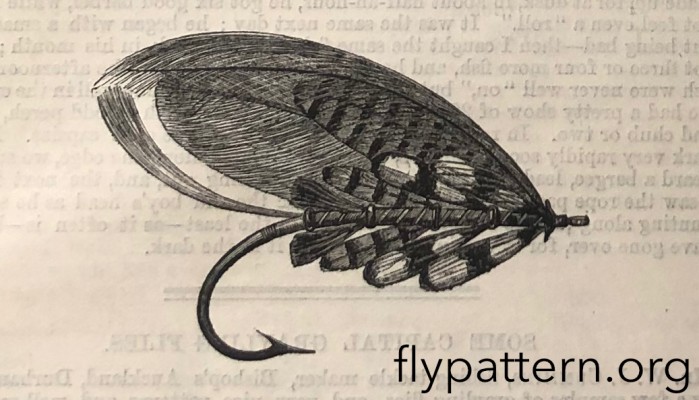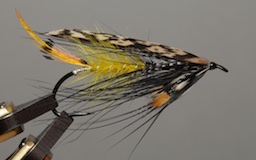| Author | Kelson, George M. |
| Book | The fishing gazette: On the description of salmon flies, Major Traherne's Patterns |
| Book Edition | N/A |
| From "The fishing gazette" - November 1st, 1884 In completing my remarks upon the throats of flies, it may be observed that I have alluded principally to feathers which are seldom if ever provided here by professional dressers. In addition to preceding observations, let me mention that the tippet of the Golden Pheasant has a very smart effect. It is not a feather that winds well, and is better fixed in fibres as suggested for those from the Amherst. I cannot call to mind any standard flies with either of these situated here, but it seems to me that they help to provide a "good change," whether used in their natural state or dyed. Crimson, magenta gives the golden ones a very taking and gay appearance, but the Amhersts come better in blue.Dyed Teal is another uncommon accompaniment, and looks exquisitely delicate in golden yellow. I allude to the hackles, wound in the usual manner, not to the more favoured side-feathers tied in fibres, which, by the way, are the making of almost all mixed wings, and it is well we should remember that both dye any shade splendidly. Strands, again, of the Summer Duck answer admirably either dyed or plain. Then Houdan hen's breas feathers I highly recommend; they are very rare, and therefore difficult to procure at any price. I mean the feathers that have a dark black ring round the edge, with creamy-white centres; and, if intended for dyeing blue, the whitest again should be chosen. The worst of them is that they are laurel-leaf-shaped, and fly-makers generally discard all such kind. Of course hackles for ordinary purposes should taper gradually, and not only be fine in texture, but transparent in appearance, running to throughout, and up to the shaft. Certainly those with fluffy lists are next to useless. It is astonishing how the hackles on poultry, whether of the male or female, are affected by diet. I remember to have seen some interesting experiments by the late Mr. B.P. Brent, and still have a few of the samples in my collection. The darker feathers of Houdans are of no value; the colour underneath is shocking, and this ought always to be a principal point in judging of any hackles that are to be employed in their natural state. Even if we take into consideration the horrid shape of this feather, it is invaluable to us on account of the superb black tips; but then, shape is not of so much importance either to throat or butt hackles, and when used in sequence for butts, working the smallest of the set first, with the colours blending well, the feathers, although hard to find, are very hard to beat. Mohair in various hues may be, and often is, added; still, it is not so effective as Goat's beard, which takes the dyes as nicely as Pig's wool, and so provides a brilliant reinforcement to any of the foregoing specialities. You know, one of the most pleasant and engaging themes of this all-important pastime (should I not say business?) of fishermen, this study, the charm of which "time dare not dull" - is the power of invention. Now we should soon be contented, and therefore soon tire, if we merely had to imitate and only reproduce; for truly, then, all art would be exiled. But is it not curious how many of us there are whose rapturous conception of ideal beauty is immeasuraly superior to the power of execution? And perhaps, so far, we may be said to be like the every-day artist, for surely the visible form we give our ideas is never "half so happy" as that seen through the golden haze of our mystical imaginations. Indeed, were it ordained otherwise we should require a gigantic collection of feathers to carry out anything approaching a truthful detail. Many a time have I asked friends how they contrieved to get this, that or the other thing in hackles, receiving the invariable reply - "by accident"; what is the moral? Always carefully measure and retain a written record of the quantities mixed in the dye bath, note the time allowed for the feather to be immersed therein, and keep samples. The dye ingredients are to be purchased of Messrs. Woolley and Co., wholesale chemists, 69, Market-street, Manchester, and their Bismarck Brown is simply magnificient. I hear a new and improved golden yellow will fetch white hackles identically the same in tone as Golden Pheasant toppings. Where fish put up with it, we can scarcely use too much hackle - of this I speak confidently; we are more likely to under than overdo it for the majority of rivers, provided also that the shades be not too gaudy and consipicuous. We must, however, remember that every so little too much will cause the fly to skirt the water, and that must be avoided. Neither, as a rule, can we select them to long in fibre - say, up to the barb of the hook. The black-pointed plumes are my especial favourites, and I believe them to be the best. Whith such feathers as Jay's, of course, a little goes a long way; then, again, undyed Gallina should not be laid on extravagantly. In "fastening-off" all throat hackles - under the hook, so that they may not molest the wing - be sure to press back their coils there before the final touch with the tying silk; and before using your thumb and middle finger nails for this purpose, unwind two or three turns of the silk - I might say all except the last, if you have had sufficient practice to make sure of its not slackening, and in replacing it you also bind for the first time the gut (which has been exposed here til now) as firmly and as closely as possible in single layer for the wings. And that is of much consequence, for without an even and unwrinkled surface it is impossible to set up the wing on either side properly. Now it is universally upheld that the wings are the most important and pleasurable part of our work, and may I say - to those who do not understand it - the most difficult. With regard to that, I think the development of practical perceptions would be hindere by any determined adherence to old-fashioned and immemorial usage, exploded traditions, and obsolete ideas. Therefore, it will be my pleasurable endeavour to explain to the best of my ability the immense advantage of "building up" the right material on this end of the hook in the right way, for I am also one of the "universal believers." Take two anglers of equal ability, persistence, and a match physically; place them on a fair footing to fish a stretch of water for a fortnight with flies the same in size and colour, those of the one dressed correctly, while the others are made coarsely with lopsided bodes, and the wings having irregular strips of feather spurting out in all manner of ways. What would be the result? Well, now, surely you know. Could there be a single doubt about it? Is an answer wanted? Yes? Then I can only say that you might very easily ascertain at any time by interrogating any such experienced fisherman as he who invented and dresed the original "Nelly" - the subject of our present illustration. Of Miss Bly's predecessor I believe I expressed a very high opinion, and although she may be so beautiful, the "Lapwing" could scarcely be surpassed. Where are frequenters of the Shannon, the Spey, Twee, Tay - let me add etcetera to save time - who could not find a few fair words in favour of this comely and gorgeous specimen of artificial entomology. A great deal has been broached from time to time of the cost of this beautiful collection; really, if we were to review these flies, what could we find to object to on that score, particularly if we omitted on of the best of all - the Chatterer? Nelly, made to sail along evenly with her Crow and her Jungle and the rest of the work in her perfect body, would require a deal of care; indeed, to fix these feathers to play regularly and in a line in the water would need much experience I maintain the effect would be lost, the attraction nearly gone, if they were to tumble together in one confused mass. My experience teaches me that salmon prefer decided patterns, whether they be sombre or showy. Green legs, pink wings, and purple toppings, or any other fantastic make-up, may just bring us into conflict now and again when all ordinary means fail; but, if my mind is made up upon any one point more than another, I candidly and fearlessly submit my implicit confidence in regard to make, colour, size and mode of presenting one's flies - oh, yes - but mine is only an opinion, after all; nevertheless, in the whole course of my travels, I have always observed ( I wonder if I may ask you to read slowly) that those who catch most fish are the most careful upon each and every of these considerations,. We are all aware there are plenty of salmon fishermen who believe otherwise, but are they the successful ones - not occasionally, but invariably? This fly may be described as follows:- Tag: Silver twist and green silk (the same shade as the green feather of the Macaw). Butt: Black herl. Body: In four equal divisions of floss silk; No. 1, the same colour as the two feathers of the red Crow, which are above and below, and butted with black herl, as also is each of the rest. No. 2, the silk is the same blue as the four Jays. The best idea I can offer of No. 3 is that the silk is the same in tone as that of a green Parrot, and a few shades darker than the tag; and No. 4 of magenta silk, each having four Jungle Cock, as shown. Ribbed: Flat silver tinsel. Wings: Two red orange Macaw feathers, with one Jay feather on either side, as illustrated which are from the overgrowth, having blue on both sides of the shaft; two golden toppings above. Horns: Blue Mackaw. Head: Black herl. |
|
| Tags | traherne, kelson, fishinggazette, |
Material
- Tag: Silver twist and green silk (the same shade as the green feather of the Macaw)
- Butt: Black herl
- Body: In four equal divisions of floss silk; No. 1, the same colour as the two feathers of the red Crow, which are above and below, and butted with black herl, as also is each of the rest. No. 2, the silk is the same blue as the four Jays. The best idea I can offer of No. 3 is that the silk is the same in tone as that of a green Parrot, and a few shades darker than the tag; and No. 4 of magenta silk, each having four Jungle Cock, as shown
- Ribbed: Flat silver tinsel
- Wings: Two red orange Macaw feathers, with one Jay feather on either side, as illustrated which are from the overgrowth, having blue on both sides of the shaft; two golden toppings above
- Horns: Blue Mackaw
- Head: Black herl

